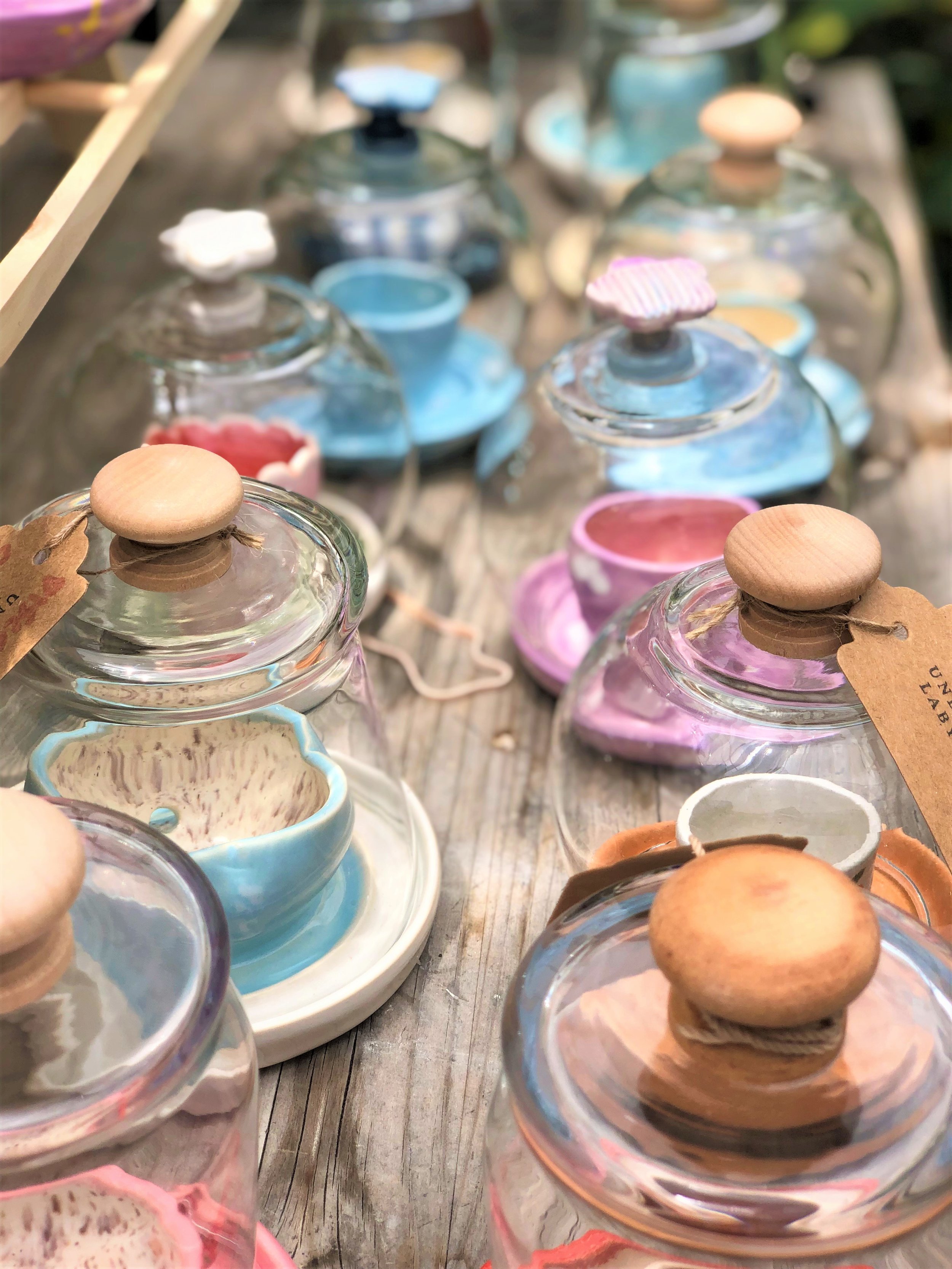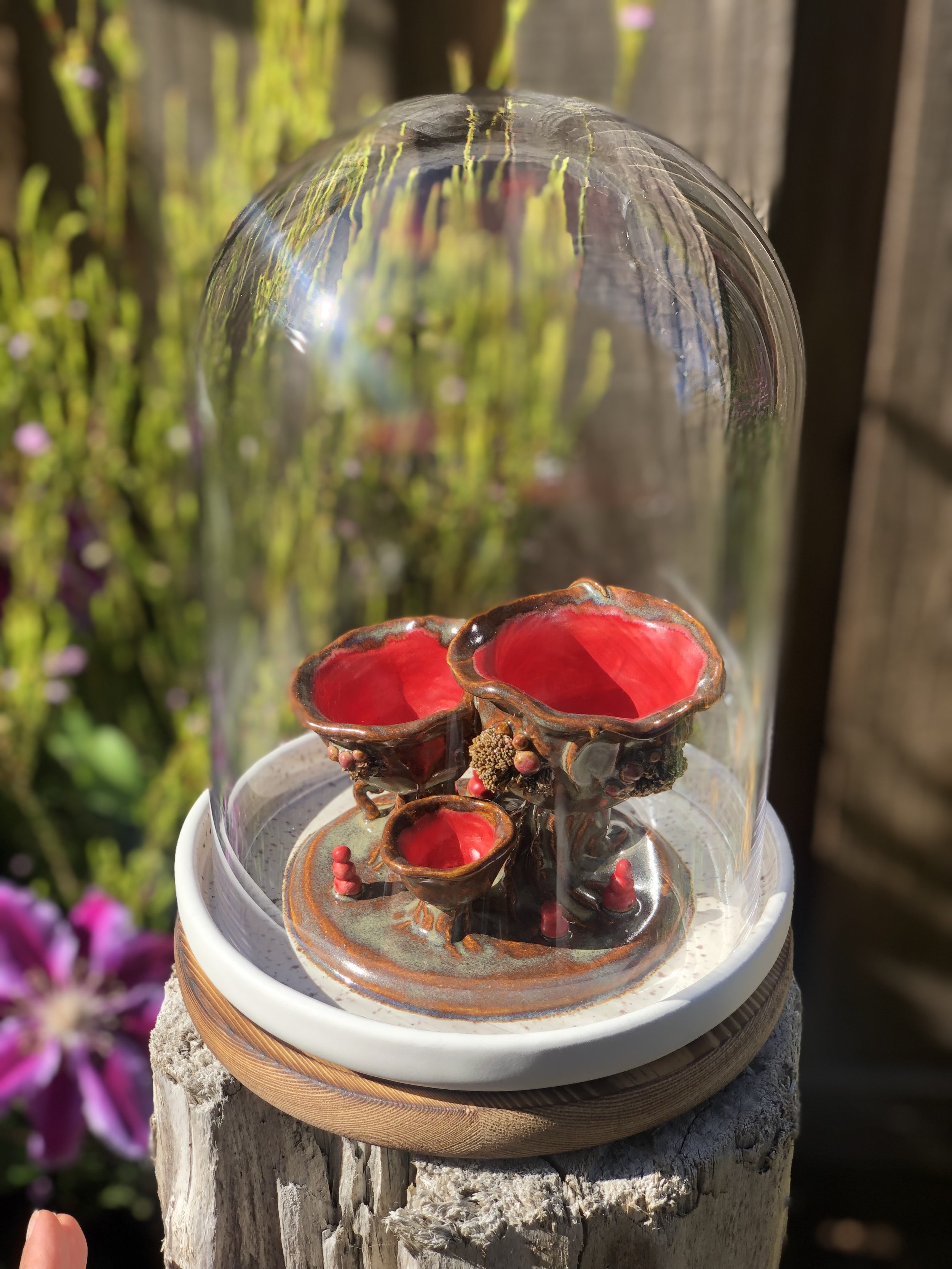GREENHOUSE GUIDE
Hi! I’m Melody Tse, the creator of Understory Labyrinth from Bay Area, CA.
Understory Labyrinth is the home of originally designed Handmade Ceramic, Cloche Greenhouses for plant propagations (cuttings, nodes, seedlings) and small plants that need rehab-ing! These greenhouses provide the humid microclimate needed during early plant stages to promote healthy root growth and establishment. Its ceramic nature provides an aesthetic and sturdy alternative to plastic containers and large glass cabinets. Once the plant outgrows the cloche, remove, and insert a new prop! Each piece is made completely unique.
Here you will find info on how to use, tips about air +light +humidity, and sizing guidelines. Proper use is required to ensure plant health.


How to Grow with Greenhouses
Plant a tropical cutting, node, seed, or humid-loving plant into the vessel using sphagnum moss or appropriate well draining soil. Place cloche in a bright warm place (Ex. windowsill with morning light) Air out your cloche on a regular basis to ensure fresh air circulation.
Key features✨🌿:
🍄Vessel includes drainage hole(s).
🍄Closed Loop water system. When you water your plant in the vessel, excess water drains into the outside perimeter, which evaporates back up the cloche to create a humid environment.
🍄 If you see condensation that indicates >90% humidity which is vital to certain plants.
🍄Ceramic material insulates heat and warmth, especially when placed on top of germination/heat pad or warm windowsill with bright but indirect light. This is good for establishing roots of young plants.
🍄Sturdy+ waterproof
🍄Easy clean, easy use
🍄Beautiful aesthetic that shows off your baby plants and cuttings 🌿 Isolates tiny plant from large collection for better care
🍄most sizes fits cozily in a warm windowsill with bright indirect light.
Notes:
The Cloche Greenhouse is intended for plants or plant stages that need humidity only. If used properly, the moist and warm microclimate will promote healthy root growth. Once the baby plant has established roots and outgrown the cloche, it can be moved out of the vessel and acclimated to a larger space. Then your cloche house is free to be reused for the next propagation! Succulents will rot/die in this environment. Please research your plant.
Air
Circulation of water and air is VITAL to plant health! stagnant water= bacterial growth, fungus growth, root rot etc. sphagnum moss and airy soil is recommended to maximize air circulation around roots. Remove the glass frequently so that old water is able to cycle out and the plant can receive fresh air.
Light
In General, Cloche Houses should be placed in an area with bright indirect light that preferably also receives a few hours of direct morning sun or late afternoon sun (when the light is at an angle and not directly beating on top of the plant). it must be SOFT direct light or the plant can burn! If the sun feels harsh on your own skin, it will be harsh on your plant. I find that my plants enjoy this softer direct light because it helps bring out vibrant color and stimulates the plant to grow more. most tropical plants at this stage are not mature enough to handle hard direct sun if at all. Light is vital for your plant to uptake water, and warmth to activate water molecules in your cloche house, to move + create humidity.
Humidity
Experiment and play with the balance of humidity. Ideally you want to see some condensation on the side of the glass to confirm presence of humidity. That means water molecules are moving = good. With no movement and aeration for water to escape, stagnant water becomes a prime breeding ground for biofilms, bacteria, or fungi. houses with more moisture will have to be aired more often to prevent stagnant water; less moisture, less often. A clue to stagnant water is it will smell bitter versus a lovely fresh forest scent. I do recommend a heating mat, especially during cold weather, to promote water movement for humidity.
There is no tight seal in these greenhouses so moisture does escape slowly. It is still wise to air out your cloche at least 3 times a week for 1 hour when you first start. More times is safer than less. Be observant and see how your plant reacts to the level of humidity to build your intuition. Then you can use your own discretion and test longer periods of closure.
I would pour out excess water after watering as moisture coming from the substrate is adequate enough (doing so, I was able to leave the cloche closed for long periods (more than a week) without any rotting issues). Different plants can handle higher or lower levels of humidity. again, use your own discretion
Understory Labyrinth Cloche House ©
Glass Cloche Size Specifications
Use this as a guide to decide what size to get. These are the specifications of the glass cloche piece excluding knobs/handles. this is the volume of space that your baby plant will have to grow.
Small Round
3.25 inch Height
~4 inch equator
~3 inch mouth diameter
Medium Round
3.5 inch Height
~4.5 inch equator
~3.5 inch mouth
Large Round
4.5 inch Height
5 inch equator
3.4 inch mouth
XL Round
4.5 inch height
5.5 inch equator
3.8 inch mouth:
XXL Round
6 inch height
7 inch equator
5.8 inch mouth
Medium Round Ruffled
5 inch height
4.5 inch equator
3 inch mouth
Small Cylinder
4 inch Height
~3 inch wide
~3.25 inch mouth
Bell
3.5 inch Height
~3.5 inch wide
~4.25 inch mouth
Mini Dome
~4.75 height
3.5 inch widest diameter
2.75 inch mouth
Flat Dome
4 inch mouth
5.5 inch height
widest diameter ~4.5 inch
Dome
glass cloche size varies and will be specified on the individual listing.
Concave Dome
5.3 inch mouth
4.5 inch shortest width
9 inch height
Storybook
glass cloche size varies and will be specified on the individual listing.
Vessel Size
Vessel sizes are approximately 1.5-3 inches high and have a mouth diameter of approximately 1.5-3 inches. Small/Medium/Large Round, Bell, and Mini Dome, tend to fall in the 1.5-2 inch diameter range. Flat Dome, XL Round, and Larger Domes tend to fall in the 2-3 inch diameter range. Pieces that have a unique size will be noted in the listing.
Weight varies with each piece and the price is adjusted accordingly.
“Seconds” pieces
“Seconds” pieces are pieces that have small cosmetic defects like, cracks, fissures, chips, dents etc but are still fully functional with a handmade charm. Most defects are unnoticeable once the piece is in use. Due to its discounted nature, all sales are final.
Understory Labyrinth “Fungus Cup Trio” Storybook Greenhouse ©




